The $60 CPU Question: AMD Athlon 200GE or Intel Pentium Gold G5400? A Review
by Ian Cutress on January 14, 2019 8:00 AM ESTCPU Performance: Rendering Tests
Rendering is often a key target for processor workloads, lending itself to a professional environment. It comes in different formats as well, from 3D rendering through rasterization, such as games, or by ray tracing, and invokes the ability of the software to manage meshes, textures, collisions, aliasing, physics (in animations), and discarding unnecessary work. Most renderers offer CPU code paths, while a few use GPUs and select environments use FPGAs or dedicated ASICs. For big studios however, CPUs are still the hardware of choice.
All of our benchmark results can also be found in our benchmark engine, Bench.
Corona 1.3: Performance Render
An advanced performance based renderer for software such as 3ds Max and Cinema 4D, the Corona benchmark renders a generated scene as a standard under its 1.3 software version. Normally the GUI implementation of the benchmark shows the scene being built, and allows the user to upload the result as a ‘time to complete’.
We got in contact with the developer who gave us a command line version of the benchmark that does a direct output of results. Rather than reporting time, we report the average number of rays per second across six runs, as the performance scaling of a result per unit time is typically visually easier to understand.
The Corona benchmark website can be found at https://corona-renderer.com/benchmark
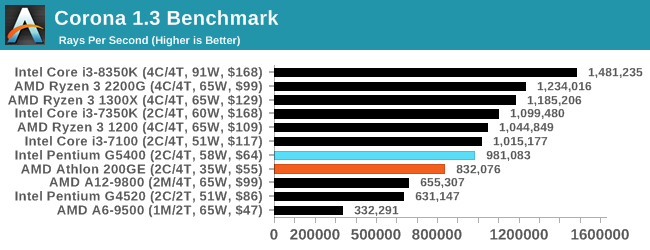
Corona is an all-threaded test, and Intel’s frequency advantage comes into play here with a 15% win.
Blender 2.79b: 3D Creation Suite
A high profile rendering tool, Blender is open-source allowing for massive amounts of configurability, and is used by a number of high-profile animation studios worldwide. The organization recently released a Blender benchmark package, a couple of weeks after we had narrowed our Blender test for our new suite, however their test can take over an hour. For our results, we run one of the sub-tests in that suite through the command line - a standard ‘bmw27’ scene in CPU only mode, and measure the time to complete the render.
Blender can be downloaded at https://www.blender.org/download/
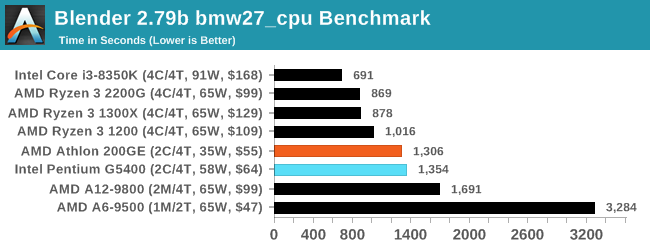
Blender also uses a mixed instruction workload, though not to the extent that our 3DPM and y-cruncher workloads do. But as with those tests, we get an AMD win of 3.7%.
LuxMark v3.1: LuxRender via Different Code Paths
As stated at the top, there are many different ways to process rendering data: CPU, GPU, Accelerator, and others. On top of that, there are many frameworks and APIs in which to program, depending on how the software will be used. LuxMark, a benchmark developed using the LuxRender engine, offers several different scenes and APIs.

Taken from the Linux Version of LuxMark
In our test, we run the simple ‘Ball’ scene on both the C++ and OpenCL code paths, but in CPU mode. This scene starts with a rough render and slowly improves the quality over two minutes, giving a final result in what is essentially an average ‘kilorays per second’.
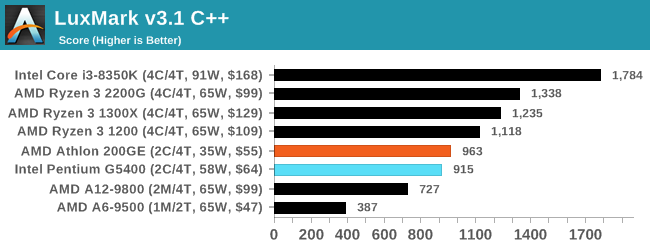
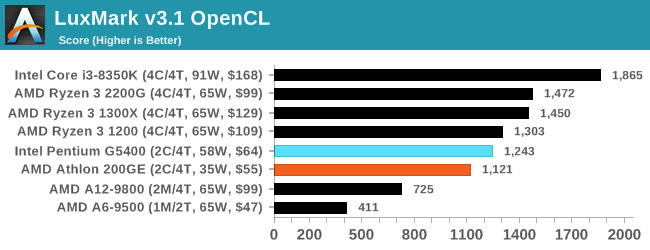
Interestingly we see AMD take the win for the C++ code by 5%, but Intel gets ahead with the OpenCL code (running purely on the CPU) by 10%.
POV-Ray 3.7.1: Ray Tracing
The Persistence of Vision ray tracing engine is another well-known benchmarking tool, which was in a state of relative hibernation until AMD released its Zen processors, to which suddenly both Intel and AMD were submitting code to the main branch of the open source project. For our test, we use the built-in benchmark for all-cores, called from the command line.
POV-Ray can be downloaded from http://www.povray.org/
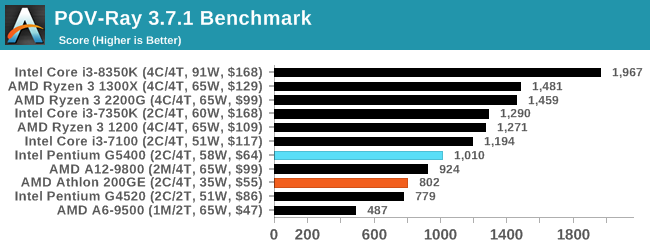
As another throughput test, here AMD is behind by 20%.











95 Comments
View All Comments
Ryan Smith - Tuesday, January 15, 2019 - link
To be sure, the normal price on the G5400 is ~$64. Past that, we have no specific control over whatever pricing shenanigans Amazon and its partners are up to at any given moment.Irata - Tuesday, January 15, 2019 - link
Define "normal". Yes, the MSRP (manufacturer's suggested retail price) is $64, but you cannot - and have not been able to for a while - find the G5400 anywhere near this price (for stores that actually have them in stock).In terms of pricing - it's not just Amazon or Newegg - many posters here checked sites in various countries and it is more expensive everywhere.
So imho, "normal" pricing would be the actual street price. And if you look at current prices, the Athlon GE's counterpart is actually a lower clocked 2C2T Celeron G4920 with half the G5400's L3 cache or alternatively, the G5400's counterpart would be the Ryzen 2200G / Ryzen 3
As Ian stated that he bought this in Retail - where and when ?
It would have good to either base the review on actually available parts / street prices or add a caveat stating that the G5400 is not available for the msrp.
yannigr2 - Tuesday, January 15, 2019 - link
Bravo, you said everything.People will read this review, go to ANY shop, see the processor at double price and buy a Celeron. because the review told them that the Intel processor is faster in most tasks. This is how consumers behave, especially when they don't have technical knowledge. That's how an RTX 2080Ti sells a GTX 1050 when the RX 570 is faster in every way.
This article is posted for a specific reason, and that's not a fair comparison.
JMO
shabby - Tuesday, January 15, 2019 - link
That's your excuse? We're not first graders here, when an article is based on the price you better make sure no shenanigans affect the price, try harder next time.drzzz - Tuesday, January 15, 2019 - link
What a crappy response Ryan. Given the entire mess about pricing that was made over the i7-7700K a few years ago by this very site. Arguing that street price is the valid metric vice MSRP at the time. Given the article was released without even one editor's note about the G5400 not being available anywhere for the MSRP was just a mistake. Own up to it and correct the article. When I can get a 2400G for the same price as the G5400 there is no comparison in performance or value. Looking at how much of the comments are about the price issues vice any other point from the article and face palm is all I can think about.yannigr2 - Tuesday, January 15, 2019 - link
Really? Is Amazon dictation the G5400 price on the planet? I thought Intel was doing it. Because there is no chance to find this processor at that price on the planet. At least not as new.It WAS nice reading Anandtech this last 15 years.
SaturnusDK - Tuesday, January 15, 2019 - link
No Ryan. The "normal" price is not $64. It's the 1k unit price. You'll probably never see this retail at less than $69... at best.The_Assimilator - Tuesday, January 15, 2019 - link
FFS, all you dipshits complaining "bu... bu... but... G5400 isn't $60" should actually look at the MSRP on Intel's site: https://ark.intel.com/products/129951/Intel-Pentiu...I agree that the chip isn't selling at anywhere near that due to shortages, but Ian has to take a baseline from somewhere and MSRP makes the most sense.
Irata - Tuesday, January 15, 2019 - link
Point taken about the baseline but what's the point of the review if you cannot get the CPU for the MSRP ? The one that's closest price wise is actually a Celeron G 4920.The alternative would have been to either mention that current prices are a lot higher or post the article once the G5400 is again available for MSRP.
Haawser - Tuesday, January 15, 2019 - link
When RX series GPUs were being pushed into stratospheric pricing by mining did reviews quote their 'normal' price, or the price people could actually buy them at ? So why are the rules suddenly different when the situation is reversed and it's the AMD product that's the cheaper option ?